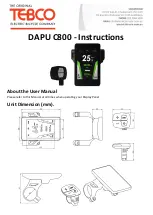
24
b
c
d
a
An inappropriately adjusted power modulator may result in
severe accidents. Ask at a bicycle specialist shop of your trust
about the system your bicycle is fitted with.
5.2.1.3 Synchronising and Readjusting.
Almost all brake designs have a bolt located next to one or both brake
callipers for adjusting the initial spring tension
(a)
. Adjust this bolt care-
fully until the distance between brake pads and rim is the same on either
side.
To adjust the brakes, unscrew the knurled lock ring located at the point
where the brake cable enters the brake lever on the handlebars
(b)
.
Unscrew the knurled, slotted adjusting bolt by a few turns. This reduces
the free travel of the brake lever. Keeping the adjusting bolt firm, tighten
the lock ring against the brake lever mount. This prevents the adjusting
bolt from coming loose by itself.
Ensure that the slot of the bolt faces neither forward nor upward, as this
would permit water or dirt to enter.
Always test the brakes’ function while stationary after adjust-
ing them, making sure the brake pads engage fully with the rim
when you pull them hard.
5.3 Disc Brakes.
The most striking feature of disc brakes
(c)
is that they combine out-
standing braking power with good weather resistance. They respond a
lot faster in wet conditions than rim brakes do and achieve their normal
high braking power within a very short time. They require fairly little
maintenance and do not wear down the rims as rim brakes do. However,
they tend to be noisy when they are wet.
New brake pads have to be bedded in before they reach their
optimal braking performance. For this purpose, accelerate the
bicycle 30 to 50 times to around 30 km/h (18 mph) and bring it
to a halt each time. This procedure is finished, when the force
required at the lever for braking has stopped decreasing.
The brake levers can be adjusted to the size of your hands, allowing you
to operate them with optimal effectiveness. In most cases this is done
by means of a small Allen bolt located directly at the brake lever
(d)
. You
may need to readjust the brake pads, as well. Please read the manual of
the brake manufacturer.
With mechanical disc brakes the travel of the brake lever becomes
longer as the brake pads wear down
((a) p. 25)
. It is therefore necessary
to readjust these brakes regularly. If you are in doubt or if you have any
questions, please contact a bicycle specialist shop of your trust!
















































